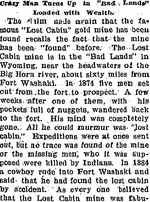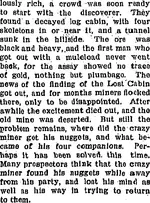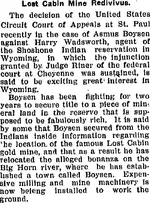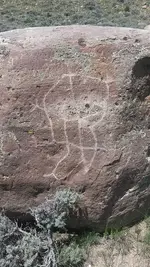Oroblanco
Gold Member
- Joined
- Jan 21, 2005
- Messages
- 7,841
- Reaction score
- 9,876
- Golden Thread
- 0
- Location
- DAKOTA TERRITORY
- Detector(s) used
- Tesoro Lobo Supertraq, (95%) Garrett Scorpion (5%)
- #1
Thread Owner
The Lost Cabin Mine
The most famous lost mine legend of Wyoming is the Lost Cabin. The story goes that several prospectors, from three to seven, had ventured into the Bighorn mountains in quest of gold. They built a cabin to live in and a flume or sluice to work their discovery, a rich gold placer and amassed a considerable amount of gold when they were suddenly attacked by Sioux or Cheyenne warriors who killed all but one survivor.

The lone survivor made it out to a fort where he told his story and showed gold, the fort usually named is Fort Reno on the east flank of the range. There are two versions of what happened next, the survivor either sickened and died without giving a map or good directions to the mine, or he had assembled a group of partners to accompany him back to the mine, but on their trip they were all massacred by Indians with no survivors.

The mine has been found and lost repeatedly, and in several cases the person who discovered the cabin and mine was unable to find it again. The search area is huge - for the Bighorn range runs a considerable distance. Fort Reno no longer exists but as the mine was some three days travel from the fort, it could be almost anywhere in the range. Key points are that it was a running stream, that there was a cabin built which was still standing some years later, and that a flume or sluice had been built.

By this time the cabin may be long gone - or the Indians may have burned it, but the gold would still be there waiting for a lucky treasure hunter to dig it up again.

I would like to hear any theories or ideas, opinions etc. My wife and I have hunted this lost mine in the southern part of the range some years ago, and had no luck but that should not discourage you. Thank you in advance,
Oroblanco



The most famous lost mine legend of Wyoming is the Lost Cabin. The story goes that several prospectors, from three to seven, had ventured into the Bighorn mountains in quest of gold. They built a cabin to live in and a flume or sluice to work their discovery, a rich gold placer and amassed a considerable amount of gold when they were suddenly attacked by Sioux or Cheyenne warriors who killed all but one survivor.

The lone survivor made it out to a fort where he told his story and showed gold, the fort usually named is Fort Reno on the east flank of the range. There are two versions of what happened next, the survivor either sickened and died without giving a map or good directions to the mine, or he had assembled a group of partners to accompany him back to the mine, but on their trip they were all massacred by Indians with no survivors.

The mine has been found and lost repeatedly, and in several cases the person who discovered the cabin and mine was unable to find it again. The search area is huge - for the Bighorn range runs a considerable distance. Fort Reno no longer exists but as the mine was some three days travel from the fort, it could be almost anywhere in the range. Key points are that it was a running stream, that there was a cabin built which was still standing some years later, and that a flume or sluice had been built.

By this time the cabin may be long gone - or the Indians may have burned it, but the gold would still be there waiting for a lucky treasure hunter to dig it up again.

I would like to hear any theories or ideas, opinions etc. My wife and I have hunted this lost mine in the southern part of the range some years ago, and had no luck but that should not discourage you. Thank you in advance,
Oroblanco










 They all just said it was myth, which I also still believe it to be - at least in the form it exists told in story.
They all just said it was myth, which I also still believe it to be - at least in the form it exists told in story.